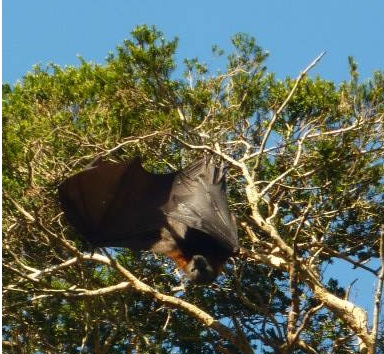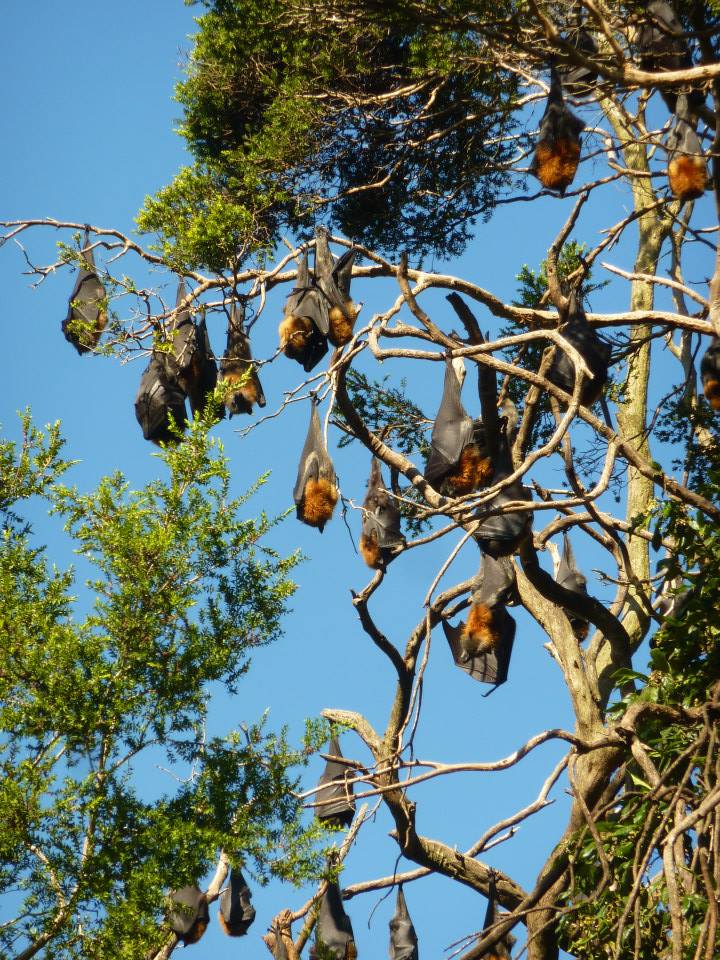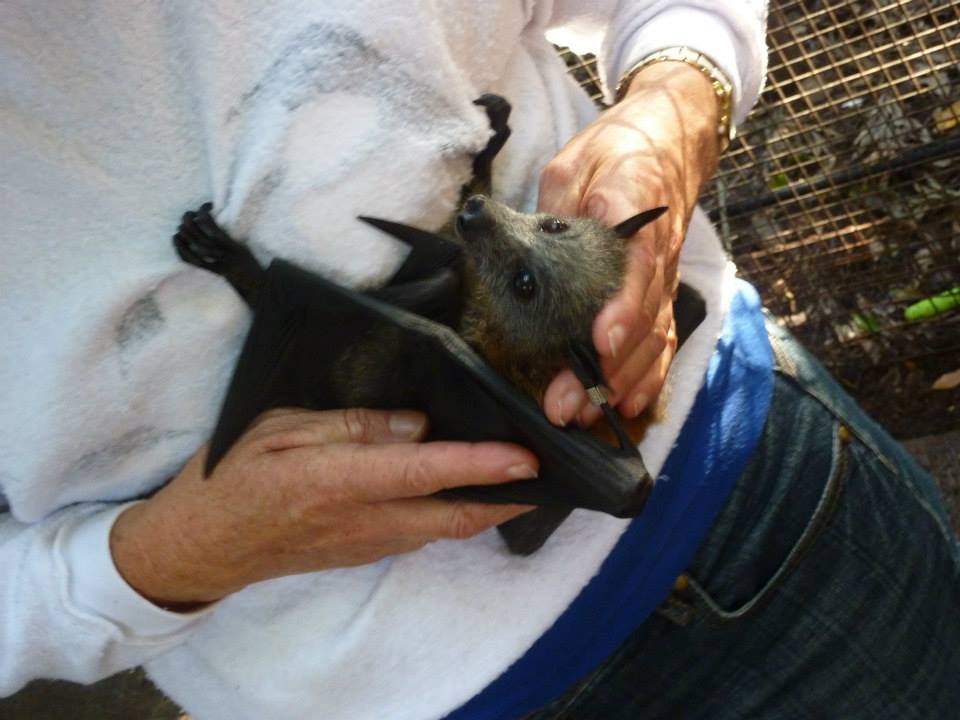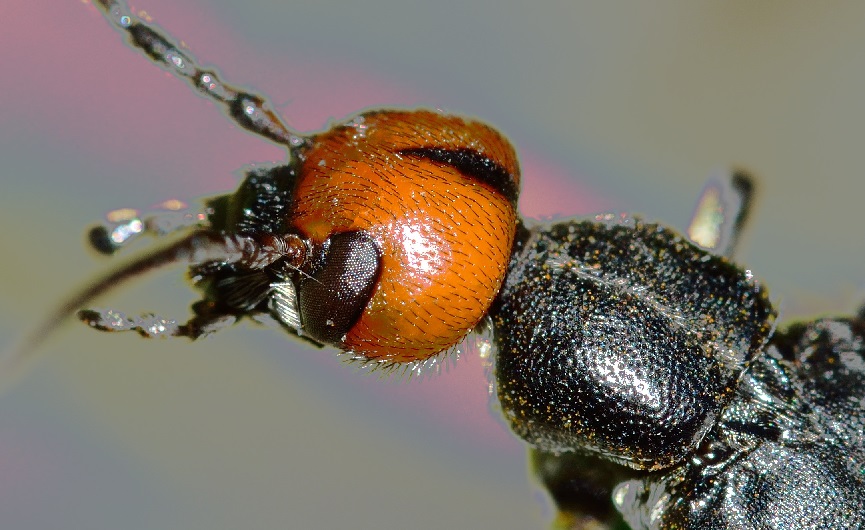Bats and Ebola
Article curated by Rowena Fletcher-Wood
Ebola is one of the most contagious and dangerous viruses known to humanity, spreading rapidly and killing the overwhelming majority of those it infects. Outbreaks are intermittent though, so for the disease to survive there must exist some environment it can live in without destroying – a natural reservoir for the disease. Some animals can be infected with the disease and still survive, making them the leading candidates for this natural reservoir. Today, no wild source of Ebola has been identified – bats are a guess. We don’t know which animals or plants Ebola hides out in, nor the pathway it takes to get into humans. But there are certainly good reasons that bats have soared to the top of the suspect list – their history ofzoonotic diseases.

It’s hard to know what diseases bats may or may not harbour. As animals go, they’re relatively clean and seldom carry fleas or lice. But when they do carry diseases, they only ever seem to be devastating ones like rabies and marburg. This might be due to the bats’ complex immune system.
The bat immune system is suspected of protecting them against cancer and DNA damage as well as pathogens, meaning that bats really do develop tumours only very rarely. Researchers believe they’ve had to develop this immensely powerful immune system because bats use a lot of energy to fly (they have much denser bones than birds), and using energy produces a large number of free radicals, which normally causes cell and DNA damage. If they didn’t have a super immune system, all bats would get cancer or DNA damage and die off young. Instead, bats have far, far more genes coding for DNA damage detection and repair than other mammals[1]. This isn’t because the bat genome is particularly special or has things on it that other mammals don’t: on the contrary, bat super-immunity happens because bats have more genes switched on – if you like, the so-called junk DNA is helping. These genes are concentrated in the DNA repair part of the genome, and may differ between bat species. In some animals, these genes switch on temporarily as a threat response against extreme diseases, but for bats it seems that if they’re on, they’re always on. Researchers think these gene clusters could give them a new picture of the evolutionary pathway towards mammal flight.
When bats fly, something else rather amazing happens: their body temperature rises up to 40 °C, as if they were experiencing a fever[2].


Hot Topic
In the past, researchers have thought the bat thermoregulatory centre might be linked to migration, however, although seasonal north-south bat migration has been studied, there has as-yet been no conclusion reached about what drives them to migrate thousands of kilometers twice a year. Some scientists think it may be behavioural thermoregulation, controlled by their drive to maintain an even body temperature, however, so far the biological evidence is missing and bat movements remain a mystery, making them hard to track for research purposes. The thermoregulatory system – the network of actions such as shivering – usually works to maintain body temperature in a very narrow band around 37.7-39 °C for most mammals. Go outside this and we get hypo- or hyperthermia, which is ultimately life-threatening. How and why bat internal temperatures increase so much when they fly is still unsolved, but it certainly helps them: a fever is the body’s slightly unpleasant way of getting rid of nasty diseases by cooking them, and at this temperature most bacteria and viruses perish. But not all of them. The ones that are left tend to be the really nasty, really robust ones that human fevers can’t shake off either. These will either kill the bat rapidly, as lyssavirus (a rabies-like disease) does, often too quickly for them to get passed on, or live on in the bat without harming it too much – as hendra and marburg do – and the bat becomes a carrier. Since bats love company, diseases spread rapidly across bat communities.


Are Bats Ebola Hosts?
When humans do catch Ebola, they suffer a haemorrhagic fever, often fatally. These severe consequences make us keener to understand and fight this disease.
Why it’s hard to know
Surprisingly, given the interest in it, not that much work has been done looking for a source. This is because it’s rather tactless to travel to Africa and go rooting through the local wildlife when villagers are dying of a horrific disease. But by the time the human outbreak is over, the sources have withdrawn and evidence has faded.
Even in the midst of an outbreak, identifying the source isn’t easy.
Afterall, Ebola is not a common disease. This means it’s either hosted in something we don’t come across very often, or it’s rare in the host. This makes the whole operation into a bit of a numbers game – how many bats, spiders, rats or other animals do you need to test before you can clear them? Probably thousands – or tens of thousands. For each species. In diverse African forests. That’s not only an exhausting task, but time-consuming and expensive.


Why do people suspect bats spread Ebola?

1. Ebola in bats is feasible.
To survive, a virus needs a living host to live and replicate inside. A good virus host needs to be susceptible to the disease, transmitting it pretty easily to other members of its species, and not be crippled or die from it (at least not for a long time).
Bat communities consist not only of colonies, but of larger and smaller groups. Bats will roost not only with their own species and colony, but with other kinds of bats and other colonies as they cross similar territories. They also have complex social structures, the colonies divided into smaller family groups or sub-colonies within which the bats share their food and help to groom each other. The sub-colonies are ruled by older females, matriarchs, who organise cooperation between groups with the help of their daughters and granddaughters. Bats are socially intelligent and recognise the difference between bats in their own colony and similar bats from other colonies. Even after long separation such as hibernating, bats will instantly identify their own members and greet each other by nose rubbing. Scientists aren’t sure how they remember each other; smells and calls have been proposed as possible colony signifiers.
Because of the hugeness of colonies and the fact that bats are roamers, they’re hard to study diseases in and gathering and testing colonies in laboratories is virtually impossible, at least under any realistic circumstances. This makes the study of zoonotic diseases (transferrable between species) and bat immunology very tricky, and we currently have only a limited understanding[3]. Because of this, because snuggling bats pass diseases readily between them, and because the diseases bats do carry tend to be rather scary, we have an over-exaggerated fear of disease in bats. However, whilst the impact of these diseases should never be understated, bat diseases are seldom zoonotic, and those that are are often preventable, and hardly ever seen anyway, since we don’t come into direct contact with bats very much. Since its discovery in 1995, three unvaccinated people have died of Lyssavirus after bat contact, and four people have died of Hendra since it was first recorded in 1994.
Incidences of bat-related diseases have increased recently, and it’s possible Ebola is one of them. This is thought to be because of humans expanding into bat territories in places like the tropics.
Two key studies also suggest that some kinds of bats are feasible hosts for Ebola – that is, they might be able to contain it, and they might have come into contact with it in the past[4][5].
Professor Robert Swanepoel from the University of Pretoria put Ebola into 24 kinds of plants and 19 kinds of animals. In most, the virus died, but it survived and replicated for 12 days in a fruit bat and a free-tailed bat, and the bats themselves also survived[4]. Other kinds of bats have been shown to be immune (such as the almost-certainly innocent African straw-coloured fruit bat, which has been blamed). A spider also contained the virus, though not so well.
Professor Eric Leroy from the IRD in France sampled 679 fruit bats, and found 16 with Ebola antibodies and 13 with traces of Ebola RNA[5]. Finding virus RNA implies the animal came into contact with the virus, and suggests it was probably infected, but doesn’t tell us whether it acted as a host or rapidly flushed the virus out. In fact, the absence of any live virus implies it most likely flushed the virus out.


In 2019, researchers examined a Rousettus fruit bat from south China and identified a new type of filovirus in its liver: the Měnglà virus; this is substantially different from both Ebola and Marburg, showing that bats are plausible hosts, and also expressing the genetic diversity of filoviruses in bats[6]. It can infect monkeys, hamsters, dogs, and humans, but the effects in these species are as yet unstudied.



2. Bat contact is possible.
The outbreak of Ebola in 2014 was eventually traced to a two year old boy, Emile Ouamouno, also known as patient zero. Researchers investigating how he might have got hold of the disease eventually came across a hollow tree – previously full of bats. Now, however, it wasn’t: the tree had been burnt, cleansing it of the organic evidence that could've told us one way or the other whether bats were carrying Ebola.
Some DNA was detected in the ash of the tree, however, showing that the bats were the insect-eating Angolan free-tailed bats villagers had described. These were one of the kinds that Swanepoel had managed to put Ebola in, making them a possible candidate.
But to spread Ebola, a person has to make contact with bodily fluids like blood; it’s not enough to just be near a host. Often, disease spreads “zoonotically” from wild animals when they are eaten by people. Wild animals that are eaten are called bushmeat, and includes bats. In fact, some report that children in the village sometimes caught and roasted the bats, so it’s possible Emile, even if he was only two, could have eaten one. Unsurprisingly, bushmeat is a relatively common source of zoonotic blood-borne diseases in Africa, which may well start with women or children instead of hunters.
But we still don’t know. When the hollow tree burnt, there were many bat casualties and, in the spirit of bushmeat, the villagers gathered them up. But before they could eat them, the government banned bushmeat, and so they threw the bodies – and evidence – away.
So why can’t we know?
We haven’t found Ebola in wild bats – or in anything. And if we did, we’d need to find it in something we know Emile came into contact with. Proving it’s viable in a controlled lab environment isn’t really the same thing. Sometimes things can work in a lab that, outside the lab, don’t. Besides, what about that spider?
Ebola RNA traces and antibodies also aren’t enough to say that an animal could catch, harbour and transmit a disease, let alone that it did. It’s only possible. The National Geographic compared finding these traces to yeti footsteps in the snow – we don’t even know if it’s something real. To put it into context, Ebola antibodies have been found in dogs too – and one dog whose owner died of Ebola was euthanised – but there’s no evidence that dogs can transmit Ebola at all.
Not all evidence supports the bat-carrying-Ebola theory.
Researchers from the Albert Einstein College of Medicine showed that whilst some bats were resistant to Ebola, only a very tiny change in the virus was needed to overcome that resistance[7]. So why hadn’t it adapted? The only logical explanation was that it hadn’t had enough contact with the resistant bats – so was it ever present in the bat population at all?
In addition, people tend to get Ebola from bushmeat and contact with the forest, but not caves. Marburg, which we know is carried by bats, tends to enter humans who work or visit caves and mines. This must mean that Ebola either does not occur in bats, or only occurs in forest-dwelling bats. And this brings us to the same question – why hasn’t it spread? Bats, after all, like to cosy up together in their roosts and share microbes between their species.
Some have proposed culling bats, but an easier, cheaper and more functional solution would be to leave bats alone entirely, including avoiding bushmeat.


Documentations have demonstrated that, for unknown reasons, Ebola relapses are possible. Scientists put it down to increased replication of the virus in a specific site, but can’t say why it happens. The condition is known as relapse-symptomatic illness, as no one is sure if it’s the ‘same thing’ as the parent disease.


If it’s not bats, what is it?

It’s also a problem: there are many, many kinds of insects: where would we begin looking?


Call of the Wild
Bat societies consist of large and complex communities, so it seems unlikely sound is the only way they communicate. Scientists have speculated about how else they might communicate and remember each other, and believe that smells, physical gestures and calls are likely to be the key ones.
Science doesn’t sleep, and it’s late when the bat scientists come out – armed with recording devices, determined to make sonograms of the noises of the night and open a window into another community. This community is the bat community, noisy flying mammals that use sound to echolocate insects, bouncing hunting cries off their prey in bursts that become higher and higher in frequency as they hone in and locate them more accurately, ending in a characteristic “feeding buzz”.
Of course, they don’t only use sound to find food. Bats are highly vocal, and as some (especially fruit bats) rely more on their eyes and noses for hunting, they instead use their mouths to find their way about or to socialise. Yet scientists think we’ve only recorded a third of their hunting calls, and 5% (if that) of their social calls. This means we have very little bat communication to go upon and a lot left to find out about. Which is exactly what bat surveys are trying to do. By recording more bat calls, we gather more of the information bats leak acoustically.
We can’t actually hear most of these cries, but by recording them, scientists can tune them to frequencies that we can. Bats call in the ultrasonic – over 20 kHz, which is a high frequency, with a short wavelength. Shorter wavelengths of sound are more likely to bounce off smaller objects like insects, and the higher the call, the shorter the range but the more fine the detail. Social calls are a little lower than hunting calls, and the ones we’ve found so far are more complex.
Learn more about Bat chat.


 2
2Once appropriately tuned, it turns out humans have a natural knack for picking up, identifying and tracking bat calls, whereas computers are pretty bad, over emphasising the importance of background noises which tend to confuse sequences, and finding too many possible patterns. Citizen science projects like Bat Detective make use of this natural talent by using public volunteers to decipher the bat calls from recordings.


Indicators On

Found on every continent, bats provide a unique opportunity to examine planetary symbiosis. Bats are seed dispersers, material and nutrient distributors (encouraging habitat development and reforestation), pollinators of tropical plants not pollinated by bees (like bananas), and pest controllers, eating a quarter of their body weight in insects and fruit every night – reducing incidences of malaria and other insect-carried diseases. Indeed, perhaps 99% of crop-eating insects are removed by natural predators like bats. Our use of chemical pesticides not only enters the ecosystem through these pest controllers, most significantly affecting them, but is only as low as it is because of them.
Learn more about Bats and biodiversity.


 3
3Once affected, bat populations take time to recover. Most kinds only reproduce once a year. This means that studying bats helps scientists learn not only about bats, but also about biodiversity and the health of our natural environment. Listening to bat sounds is, it turns out, rather like listening to the sound of the planet calling…
This article was written by the Things We Don’t Know editorial team, with contributions from Jon Cheyne, and Rowena Fletcher-Wood.
This article was first published on 2017-10-06 and was last updated on 2020-06-15.
References
why don’t all references have links?
[1] Zhang, G., et al., (2013) Comparative Analysis of Bat Genomes Provides Insight into the Evolution of Flight and Immunity Science 339(6118):456-460 DOI: 10.1126/science.1230835
[2] O’Shea, T,J., et al., (2014) Bat Flight and Zoonotic Viruses Emerging Infectious Diseases 20(5):741-745 doi: 10.3201/eid2005.130539
[3] Schountz, T., (2014) Immunology of Bats and Their Viruses: Challenges and Opportunities Viruses 6(12):4880-4901 doi: 10.3390/v6124880
[4] Swanepoel, R., (1996) Experimental Inoculation of Plants and Animals with Ebola Virus Emerging Infectious Diseases 2(4):321-325 doi: 10.3201/eid0204.960407
[5] Leroy, E,M., et al., (2005) Fruit bats as reservoirs of Ebola virus Nature 438(7068):575-576 DOI: 10.1038/438575a
[6] Yang, X., Tan, C.W., Anderson, D.E. et al. Characterization of a filovirus (Měnglà virus) from Rousettus bats in China. Nat Microbiol 4, 390–395 (2019). doi: 10.1038/s41564-018-0328-y.
[7] Ng, M., et al., (2015) Filovirus receptor NPC1 contributes to species-specific patterns of ebolavirus susceptibility in bats eLife 4 doi: 10.7554/eLife.11785
Recent Bats and Ebola News
Get customised news updates on your homepage by subscribing to articles













